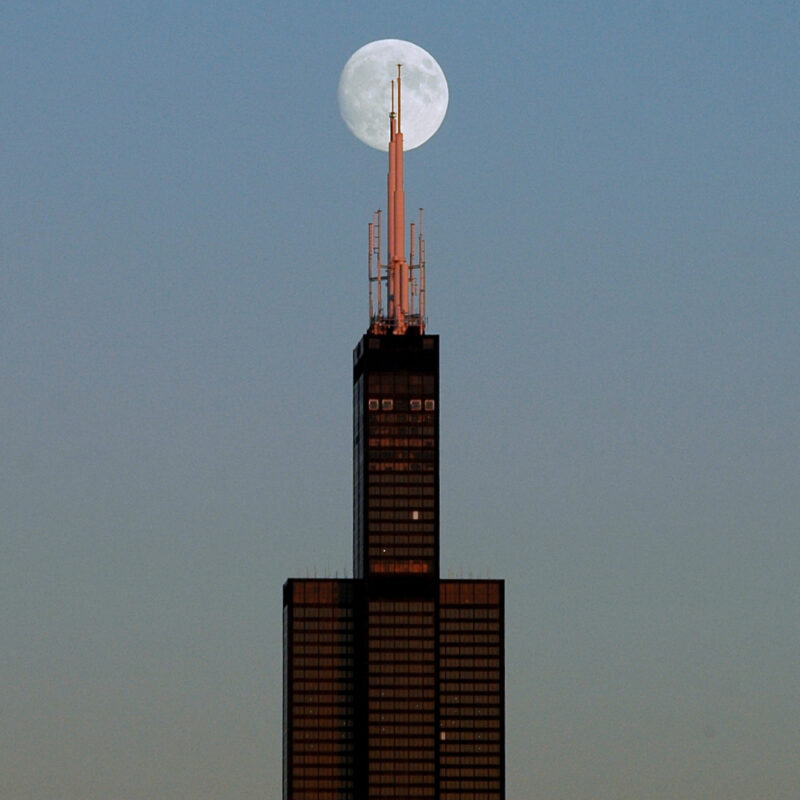Adler Skywatch: December 2024

Header Image: The full Moon appearing right above the Willis Tower in Chicago. Image Credit: Nick Lake
Check out what’s up in the night sky this December! A solstice and a major meteor shower are among the skywatching highlights this month.
The Winter Solstice
The winter solstice, marking the start of the winter season, takes place this month on December 21. In the Chicago area, this point in Earth’s orbit occurs at 3:20 am CST. For most of this month, the amount of daylight slightly decreases each day. However, after the winter solstice, this trend reverses and the amount of daylight increases slightly each day, until the summer solstice in June.
The Geminid meteor shower, one of the most active showers of the year, is expected to peak between the night of December 13 and the early-morning darkness of December 14. Over 100 Geminids per hour are usually forecast for locations with very dark, very clear skies. Unfortunately, the shower’s peak this year occurs near the full Moon, so only very bright meteors may be visible in the moonlit sky, even for viewers who are far from city lights. Finding a way to block the Moon from your sky-view may help visibility, but overall, this will be a down year for viewing this meteor shower due to the moonlight interference.
Plant Spotting This December
The brightest planet, Venus, reaches its most brilliant level for the year this month—at brighter than -4.3 magnitude. It’s easily visible low in the south-southwest about an hour after sunset, and it gets slightly higher in the sky with each passing evening. After sunset on December 4, look for a very slim waxing crescent Moon just below Venus. It’s doubtful you’ll miss seeing this brilliant planet before month’s end, but don’t worry if you do. It will continue to get a little brighter each evening until mid-February 2025. Venus sets in the southwest around 7:00 pm Central time early in the month, and in the west-southwest about 8:00 pm late in the month.
The planet Saturn is at about first-magnitude brightness this month. It’s above and further south from the much brighter planet Venus in the early evening twilight this month. Saturn starts the month in the southern skies about 50 degrees away from Venus. The two planets appear to move a little closer together each evening; so that by the end of the month, the two planets appear only about 15 degrees apart. If you look about 20 degrees below Saturn, the similarly bright star Fomalhaut (FOW-muh-lout), forms a neat triangle with Venus through the month—a triangle that shrinks a little in size each evening. Saturn sets in the west-southwest shortly before midnight Central time early in the month, and just after 9:00 pm by month’s end.
From December 3 through December 9, the second-brightest planet, Jupiter, is technically at its brightest for 2024. It’s slightly brighter than -2.8 magnitude at its brightest; but it doesn’t get below -2.7 magnitude the entire month. That’s still brighter than the brightest star in the night sky. Jupiter rises in the east-northeast shortly after the Sun sets the first half of the month. However, the planet rises earlier each evening this month; and after about mid-month, the Sun sets later each evening. As a result, the last couple weeks of the month, Jupiter gets about ten degrees above the east-northeast horizon by sunset.
The red planet, Mars, rises in the east-northeast about 8:30 pm Central time early in the month, and around 6:00 pm by the end of the month. It’s brighter than 0 magnitude all month long and gets a little brighter each evening this month. By December 22, Mars reaches -1 magnitude, and will continue to get brighter through mid-January. It gets about 70 degrees high in the southern skies during the hours after midnight, and fades away in the western skies during morning twilight.
If you have a clear view to the east-southeast horizon, you may be able to glimpse the planet Mercury, very low in the sky about an hour before sunrise, after December 12. It’s at roughly 0 magnitude brightness this month. The rising Sun blots Mercury from the sky shortly after it rises.
Moon Phases
New Moon: December 1
First Quarter Moon: December 8
Full Moon: December 15
Last Quarter Moon: December 22
New Moon: December 30
Please note: these descriptions are for the Chicago area, using Central time.
Subscribe To Skywatch Wednesday This December
Tour the sky with the Adler Planetarium’s Theaters Manager, Nick, in Skywatch Wednesday. Nick uses cutting edge visualizations, NASA images, and astrophotography to show you what you can see in the night sky throughout the year.
Check out Nick’s latest episode for your guide to winter stargazing! Nick explains how to see five planets, star clusters, constellations, and stars that are visible during the winter 2024–2025 season.He also explains how you can see the lunar occultation of Mars that will occur on January 13, 2025.
Learn From Our Astronomy Educators
Watch recaps of Sky Observers Hangout livestreams this December! Learn how to observe upcoming cosmic happenings, enhance your astrophotography skills, and see celestial objects through a telescope virtually with our astronomy educators.






